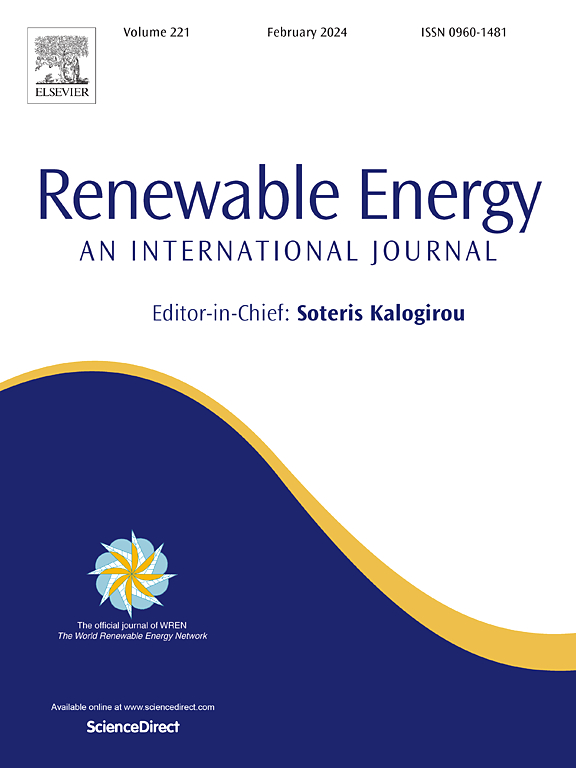结合PSR、基于nnct的多模型融合和新的优化算法的多步超前风速预报方法
IF 9.1
1区 工程技术
Q1 ENERGY & FUELS
引用次数: 0
摘要
近年来,风力发电基础设施继续呈现出可观的扩张速度。这样的增长轨迹要求风电管理方法按比例发展。准确的预测是有效治理风能系统不可或缺的因素。然而,产生准确的风速预报的任务仍然具有挑战性,因为风速时间序列数据显示出非线性模式和时间变异性。本文提出了一种结合PSR(相空间重建)、NNCT(无负约束理论)和一种创新的GPSOGA优化算法的新型混合风速预测模型。SSA(奇异谱分析)最初用于将原始风速时间序列分解为IMFs(本征模态函数),有效地隔离了基本振荡分量。随后,PSR将这些imf重构为输入和输出向量。该模型结合了四个预测框架:CBP(级联反向传播)网络、RNN(递归神经网络)、GRU(门控递归单元)和CCNRNN(与递归神经网络集成的因果卷积网络)。NNCT策略用于整合这些预测器的输出,而新开发的优化算法识别最优组合参数。为了评估所提出模型的有效性,对四个不同数据集的各种模型进行了预测结果的基准测试。实验结果表明,该模型具有较好的预测精度。通过DM (Diebold-Mariano)检验、AIC (Akaike’s Information Criterion)和NSE (Nash-Sutcliffe Efficiency Coefficient)进一步验证,该模型的预测能力优于比较模型。本文章由计算机程序翻译,如有差异,请以英文原文为准。
Multi-step ahead wind speed forecasting approach coupling PSR, NNCT-based multi-model fusion and a new optimization algorithm
Wind-based electricity generation infrastructure continues to demonstrate substantial expansion rates in recent years. Such growth trajectories demand proportional evolution in wind power administration methodologies. Precise predictions represent an indispensable element for effective wind energy system governance. However, the task of generating accurate wind velocity forecasts remains challenging, since wind speed time-series data exhibits both non-linear patterns and temporal variability. This paper presents a novel hybrid model for wind speed forecasting that integrates PSR (Phase Space Reconstruction), NNCT (No Negative Constraint Theory), and an innovative GPSOGA optimization algorithm. SSA (Singular Spectrum Analysis) is initially applied to decompose the raw wind speed time series into IMFs (Intrinsic Mode Functions), effectively isolating fundamental oscillatory components. Subsequently, PSR reconstructs these IMFs into input and output vectors. The proposed model combines four predictive frameworks: CBP (Cascade Back Propagation) network, RNN (Recurrent Neural Network), GRU (Gated Recurrent Unit), and CCNRNN (Causal Convolutional Network integrated with Recurrent Neural Network). The NNCT strategy is employed to consolidate the outputs of these predictors, while a newly developed optimization algorithm identifies the optimal combination parameters. To evaluate the effectiveness of the proposed model, forecasting results are benchmarked against various models across four distinct datasets. Experimental results indicate that the proposed model achieves superior forecasting accuracy, as evidenced by multiple performance indicators. Further validation through the DM (Diebold-Mariano) test, AIC (Akaike's Information Criterion), and the NSE (Nash-Sutcliffe Efficiency Coefficient) confirms the model's enhanced predictive capability over comparison models.
求助全文
通过发布文献求助,成功后即可免费获取论文全文。
去求助
来源期刊

Renewable Energy
工程技术-能源与燃料
CiteScore
18.40
自引率
9.20%
发文量
1955
审稿时长
6.6 months
期刊介绍:
Renewable Energy journal is dedicated to advancing knowledge and disseminating insights on various topics and technologies within renewable energy systems and components. Our mission is to support researchers, engineers, economists, manufacturers, NGOs, associations, and societies in staying updated on new developments in their respective fields and applying alternative energy solutions to current practices.
As an international, multidisciplinary journal in renewable energy engineering and research, we strive to be a premier peer-reviewed platform and a trusted source of original research and reviews in the field of renewable energy. Join us in our endeavor to drive innovation and progress in sustainable energy solutions.
 求助内容:
求助内容: 应助结果提醒方式:
应助结果提醒方式:


